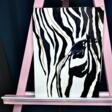Hard-edge painting

Hard-edge painting
Hard-edge painting, a distinctive style of abstract art, emerged in the late 1950s and 1960s, primarily in California. This approach is characterized by its sharp, clean edges and flat color areas, setting it apart from other abstract styles. Influenced by geometric abstraction and color field painting, hard-edge painting echoes the works of early abstract artists like Kasimir Malevich and Piet Mondrian. Key figures in this movement include Frank Stella, whose "Hyena Stomp" (1962) is a notable example, and Robert Irwin, known for his innovative use of light and perspective.
The term "hard-edge painting" was coined by Californian critic Jules Langsner in 1959, reflecting the style's precise composition and bold color use. This art form gained significant recognition in exhibitions such as the Getty Museum's Pacific Standard Time in 2011, which showcased pieces like Karl Benjamin’s "Stage II" (1958) and Helen Lundeberg’s "Blue Planet" (1965).
Hard-edge painting offers a unique aesthetic that appeals to both the intellectual and visual senses, making it a valuable study for collectors, auctioneers, and art experts. For those intrigued by the interplay of geometric forms and vibrant colors in art, subscribing to updates on new sales and auction events related to hard-edge painting is an excellent way to stay informed and engaged with this captivating art movement.
| Country: | America, Europe, USA |
|---|---|
| Start of the period: | 1959 |


